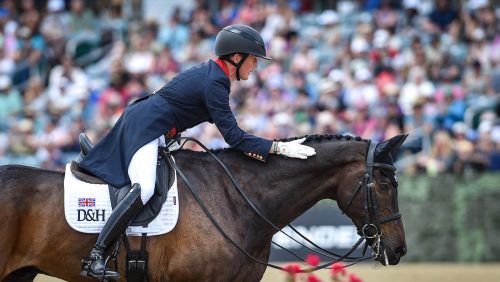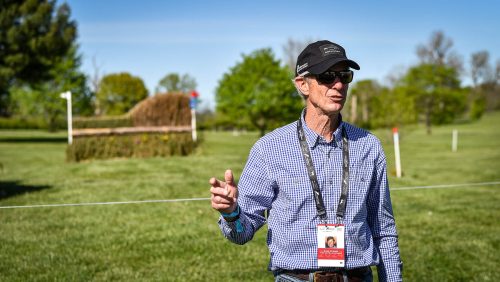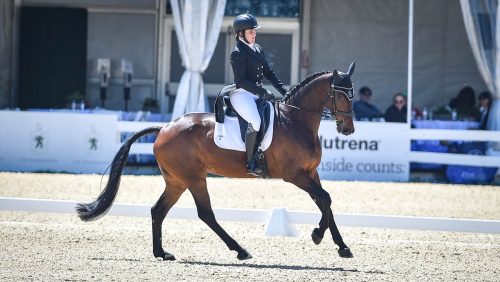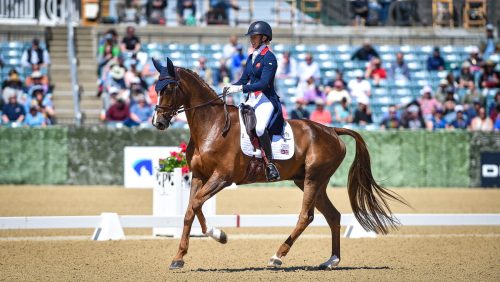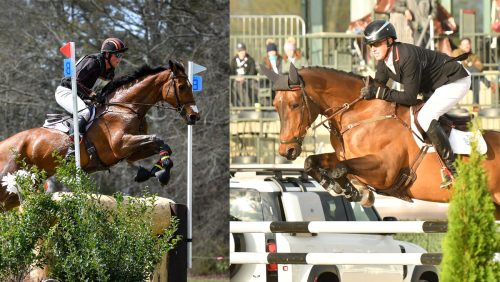Last winter, Joe Silva, executive director of the Green Mountain Horse Association (Vt.), decided to offer a new division at GMHA in 2005–a training level three-day event.
“It’s a way to give back to the huge majority of people who keep the sport going,” said Silva, who has worked as a young rider coordinator, former director of the MSPCA and its equine ambulance, a safety coordinator, and an organizer. “I just said, ‘Hey, let’s give it a shot.’ “
Silva’s not alone. These events have been offered in Canada for years and have also sprung up at events like South Farm (Ohio) and Mayfest (Ky.). Waredaca (Md.) hosted their first last year, and the concept has caught on in Great Britain too.
These events–which are not yet recognized by the U.S. Equestrian Federation or the U.S. Eventing Association–prepare riders for CCIs and provide a goal for lower-level competitors. But riders, trainers and organizers have a suspicion that these competitions, which incorporate education in pre-paring for and competing at three-days, could play an even broader role in the modern age of dwindling classic three-day events.
“It’s a really good thing,” said advanced-level rider Michael Dan Mendell, who has volunteered as a clinician at several competitions. “It helps the base of our sport understand what the sport is really about, and it may help us save the sport. I give great kudos [to the organizers]. I think this is one of the greatest benefits toward the foundation of the sport in a long time.”
Waredaca Farm in Laytonsville, Md., attracted nearly 50 riders to their inaugural three-day division last year. “Working with the population we do, in our lesson program and events, we felt it was needed,” said Waredaca owner Gretchen Butts, who’s competed at the four-star level. “I’m a classic [three-day] believer myself.”
Butts had sent students to the Mayfest three-day, and they’d come back raving about their experience.
“The educational component appealed to me,” said Butts. “For the adult amateur who’s passionate enough about their riding to [want to do a three-day], it’s a chance to give it a try in an appropriate setting.”
Clinicians at these events help riders learn the basics of a three-day–how to ride steeplechase, figure out their times for roads and tracks, jog their horses, and care for them. “If [the clinicians] weren’t excited about it, we didn’t want them here,” said Butts. “These are people who grew up doing three-days, and they wanted to share that.”
When Jim Wofford heard that Butts was offering the three-day again this year, he called to volunteer.
“Anything that has to do with the classic format, I’m very much in favor of,” he said emphatically. “There are a lot of people coming into the sport who’ve learned to ride in a ring in an urban setting, and the ‘half-star’ is a good introduction. This concept has been gratifyingly well-received.”
The list of clinicians for Waredaca’s 2005 event includes Wofford, Karen O’Connor, David and Lauren O’Brien, Phyllis Dawson, Tom Mans-mann and Pam Weidemann.
“It’s very important to see the commitment from the advanced riders to this, that they’re willing to give their time,” said Cindy DePorter, the USEA Area II chairman and co-organizer of the Waredaca three-day. “I haven’t had anyone turn me down when I called them.”
Like traditional three-days, most training level three-days do require some qualifications–generally, three or four clear rounds at recognized training level events, and Butts thinks it’s important to keep the qualifications in place.
“They had to be of a skill and experience level to run a 520 [meters per minute] steeplechase,” she said. Be-cause of the qualifications] we knew we had people who had enough training level experience that they could come and work on a different set of skills, a different challenge.”
A Shot In The Arm
Many riders see the training level three-day as a learning experience before going on to do a CCI. “I really wanted to do something to prep for a one-star but have it be lower key than a one-star,” said Andria Pooley, 17, of Iowa City, Iowa.
ADVERTISEMENT
Since she didn’t have an eventing coach in Iowa, Pooley’s experience at the 2004 Mayfest event gave her an exposure to many aspects of a three-day she couldn’t have learned otherwise. “Anything you could possibly want to know, they answered,” she said.
Mendell found that competitors like Pooley who didn’t have a regular event coach were extra motivated to learn all they could, which made his job even better. “As a coach, it’s rewarding to see students who are desperate to hear what you have to say and hang on every word,” he said.
Pooley also wanted to experience a “mini CCI” to give her insight into the controversy surrounding the sport’s format.
“I thought it would be more taxing on the horse, but my horse ran better than ever, and everyone said the same thing,” said Pooley. “They were so forward and loose when they went out of the box.”
Butts said the experience of running a training level three-day helped one of her students make the move up to preliminary. “On the steeplechase, the horse really got in front of her leg. It clicked; it made a difference to her and her horse. For her, it will get her to a one-star. For others, they’ve done the next best thing,” she said.
Even though Pooley hopes to compete in a real CCI, she would love to do the training level event year after year, with different clinicians every time.
“Everyone has a different way of doing things, and I’d love to get different perspectives on the aftercare [following speed and endurance],” she said.
Foy Barksdale, a 29-year-old financial manager of commercial real estate in Cary, N.C., competed at Waredaca’s event last year. Like Pooley, she hopes the experience will prepare her for a one-star.
“I highly recommend it if you only want to go training level, or if you plan to have the whole [one-star] experience someday,” she said. “If I ever get to a one-star, I’ll feel a little more prepared. The lectures were as educational as the ridng was. They hold your hand and walk you through the whole experience. I was most worried about the steeplechase, but it’s such a high when you come off it.”
Pooley used her experience at the training three-day to move up to preliminary two weeks later–and she now uses the horse care knowledge she gained there as she works for Ralph Hill.
But there was an even further, unexpected benefit of the event for Pooley, who won one of the divisions.
“It didn’t feel like a competition,” she said. “It was more about everybody learning together. We developed a camaraderie. Everyone was working together in the 10-minute box to cool off each other’s horses. Everyone wanted everyone else to get around.”
Beth Case, a 42-year-old research assistant from Apex, N.C. rode at Waredaca last year, and she felt one of the benefits of a three-day that’s hard to describe.
“I really wanted to experience a three-day, but I don’t have any inclination to move up to preliminary, so this is the only way I had to do that,” she said. “The process of getting ready for the event made me a better partner with my horse. I was with her so much, it enhanced our relationship, even afterwards. I hadn’t expected that.”
Butts saw her event energize the riders’ supporters as much as it did the riders. “So many people who were here helping [the riders] realized it was an attainable goal for them. They thought, ‘I could do this with my horse.’ It was like a shot in the arm to them; it gave them a mission. That was really rewarding,” she said.
“When you go to a three-day, you don’t go by yourself–you have to have a team of people. Everybody gets involved,” said Sarah Greer, who offered a training level three-day at her South Farm last year and plans to hold one again next year, skipping 2005 due to her pregnancy.
“It was a boost in the arm for coaches, grooms, parents, and people who came to support them,” Greer said.
ADVERTISEMENT
After 10 years of running horse trials, Greer saw the training level three-day as a way to keep challenging herself as an organizer–and to keep her competitors coming back.
“I wanted to add something different,” Greer said. “It’s important to involve people at all levels. The majority of riders are not even at preliminary, and they, too, can get a little bored. I wanted to know what we could do for the competitors to make it more of a learning experience and more interesting for them. It’s a good way to keep the competitors involved–they get pumped up about the sport.”
A New Recognized Level?
The competition for which announcer Brian O’Connor coined the “half-star” may be a recognized level some day, and the U.S. Eventing Association has formed a task force to study this.
According to Shelley Lambert, they hope to have rules developed to do just that by the U.S. Equestrian Federation convention in January 2006. To that effect, there will be a meeting at the USEA annual convention in December to gather members’ input on rules and distances.
“We’d like to keep it simple and educational,” said Lambert, who added that the USEA’s leaders would love to have this level included at their annual American Eventing Championships. “We hope it will help the sport grow at the bottom. It gives the real person with a real job the opportunity to do a three-day without spending the money for a preliminary horse and having to ride six days a week.”
Lambert emphasized that she and other USEA leaders hope to keep the educational aspects of the traditional three-day event alive. “With the diminishing long format, the educational aspect of teaching horsemanship is diminishing as well,” she said. “This is a chance to do it at a lower level, and that way the USEA can help it sustain itself. It’s a good cause, and I do believe in the long format. It teaches people something you can’t teach otherwise–horsemanship and sportsmanship.”
But basically, USEA leaders want to offer the division because, said Lambert, the members have asked for it. “The majority of the membership only ever reaches training level, and this gives them a huge pinnacle to shoot for that’s never been offered,” she said.
The specifications of the training level three-day–how many judges and veterinarians, required distances, heights and speeds–still need to be hammered out. “We’d love to hear any and all ideas competitors have,” said Lambert.
But Silva thinks recognition could kill his event. “It would have to be so expensive, or it would have to be a gift to the sport by the organizers,” he said. “I think a sanctioned event would work in some areas, but not for us.”
Silva is doing the event for other reasons.
“I hope the [training three-day] will help mend some of the rift between the people who are interested in the international sport and the adult amateurs,” he said. “As long as they get to play the way the sport was developed, they shouldn’t feel bad about the international sport going in different directions.
“They felt something was being taken away from them–this is a way they get to do steeplechase and still support the way the sport is going. I think training three-days are going to do a lot to mend the growing frustration and distrust,” he added.
And on a personal level, Silva offers the event as a thank you to the adult amateurs who’ve kept him in business as an organizer. “They’re the ones who want it, and as long as I can break even, I’ll do it,” he said. “It’s them taking control of their own sport.”
Added Butts, “The base of the sport is at the lower levels. You can’t neglect or omit their contributions to the association or the sport. It can’t just be the top riders who get all the headlines. Their Rolex might be completing this event.”
But beyond the education and competition, Butts just saw the riders having a great time. “It was awful weather [raining], but they wouldn’t have cared if it was snowing,” she said. “They just had a blast.”
Mendell agreed. “These people are incredibly excited on Sunday, and it’s great to see. It’s great to see them doing what they’ve dreamed about doing.”






